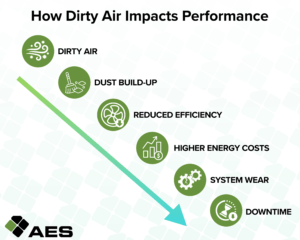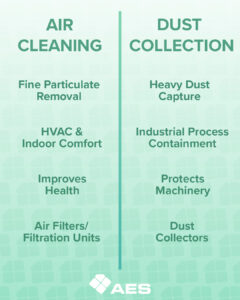The air we think is clean…isn’t
In Australia, we’re fortunate to enjoy some of the cleanest outdoor air in the world; but indoors, the story is very different. The air circulating through buildings, workshops, and manufacturing facilities often contains a surprising range of contaminants: fine dust, soot, pollen, smoke, bacteria, and even microscopic chemical vapours.
These particles are invisible to the naked eye, but they can have a major impact on both people and processes. Poor air quality affects respiratory health, reduces equipment efficiency, and can compromise product integrity in controlled environments. As urban density and industrial activity continue to rise, effective air filtration has never been more essential.
The Invisible Contaminants Around Us
Airborne pollution isn’t limited to busy cities. In rural and coastal areas, fine dust, salt crystals, and pollens all contribute to air contamination. Inside workplaces, additional sources include combustion, industrial processes, and building materials.
In a typical Australian city, the air can contain anywhere between 35 million and 350 million particles per cubic metre. In industrial zones, airborne particulate levels may reach 4.5 mg/m³, enough to damage sensitive machinery, clog HVAC systems, and reduce air handling efficiency. These contaminants circulate through ventilation and air conditioning systems, accumulating on surfaces and equipment over time
Without proper filtration, even small dust particles can cause serious operational issues, from heat exchanger fouling to mechanical wear and corrosion.
The Health and Cost Impact of Dirty Air

Airborne contaminants affect both people and performance. From a health perspective, exposure to fine particulates can aggravate asthma, bronchitis, and other respiratory conditions. Certain dusts, such as crystalline silica, found in mining and construction, can cause long-term occupational illnesses like silicosis. Bacteria, mould spores, and viruses can also spread more easily in poorly filtered air, undermining workplace safety and hygiene.
From an operational standpoint, contaminated air reduces system efficiency. Research has shown that a thin layer of soot or dust on HVAC coils can reduce heat transfer by more than 25 percent, forcing systems to work harder and consume more energy. Equipment life is shortened, maintenance costs increase, and system downtime becomes more frequent. In critical facilities such as hospitals, laboratories, and cleanrooms, airborne contaminants can even jeopardise sterile conditions and regulatory compliance.
Air Cleaning and Dust Collection: Knowing the Difference
Not every filtration system serves the same purpose. Air cleaning focuses on removing fine particles to maintain breathable, clean indoor air for occupants. Dust collection, on the other hand, captures heavier particulate matter produced during industrial or manufacturing processes before it can enter the air stream.
At AES Environmental, our systems are designed to handle both tasks. Our industrial dust collectors prevent visible airborne dust from contaminating workplaces, while our air filtration units maintain high indoor air quality for HVAC systems, laboratories, and critical production environments. Every system is engineered according to Australian conditions, air volumes, and particle loads.
Clean Air as a Standard, Not a Concept

Clean air is measurable, not subjective. According to Australian Standard AS 1668, Part 2, air supplied through mechanical ventilation should not exceed 0.06 mg/m³ of particulates, roughly equivalent to the concentration of pollen in spring air. Achieving this consistently requires properly specified and maintained air filters.
For environments that demand extremely low contamination levels, High Efficiency Particulate Air (HEPA) filters are essential. Tested to AS 4260:1997, these filters capture at least 99.97 percent of particles as small as 0.3 microns; including smoke, bacteria, and fine dust. HEPA filters are now standard across Australian hospitals, cleanrooms, and advanced manufacturing sites, where safety and precision are paramount.
The AES Environmental Approach
For more than 50 years, AES Environmental has been designing and manufacturing Australian-made filtration systems that protect both people and equipment. We build to meet Australian Standards and test to NATA accreditation requirements, ensuring every product performs exactly as specified.
Our range includes metal viscous oil filters, dry arrestance filters, HEPA and ULPA systems, and electrostatic units, each designed to deliver long service life, low resistance, and high capture efficiency. Every AES filter is engineered for performance, compliance, and sustainability, ensuring your system operates cleanly, efficiently, and reliably.
Breathe Better with AES Environmental
Clean air is fundamental to health, safety, and operational performance. Whether you’re managing a hospital, clean manufacturing environment, or heavy industrial facility, the right air filtration system protects your people and your processes.
At AES Environmental, we combine decades of local experience with global best practice in filtration design and testing. From HEPA filters to complete cleanroom systems, we deliver solutions that stand up to Australia’s toughest environments.
Contact us today to find out how we can help you breathe easier.
